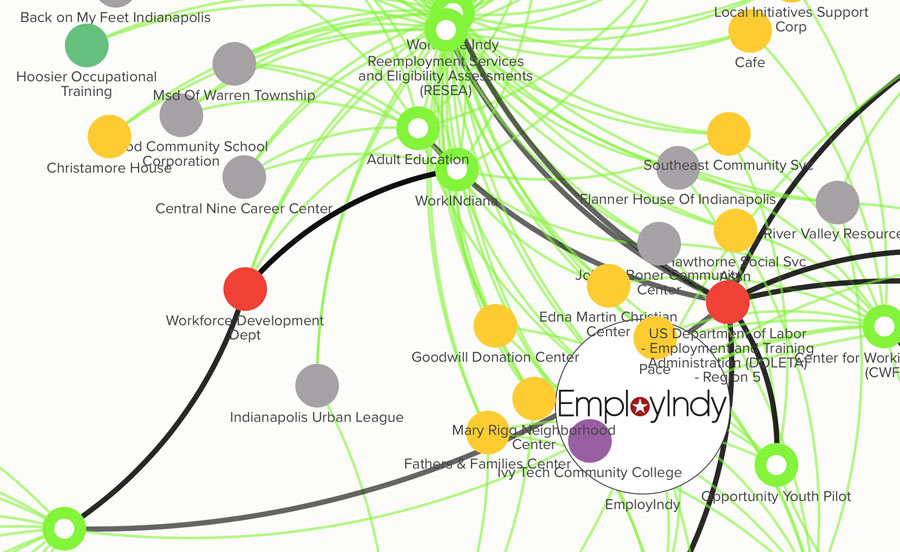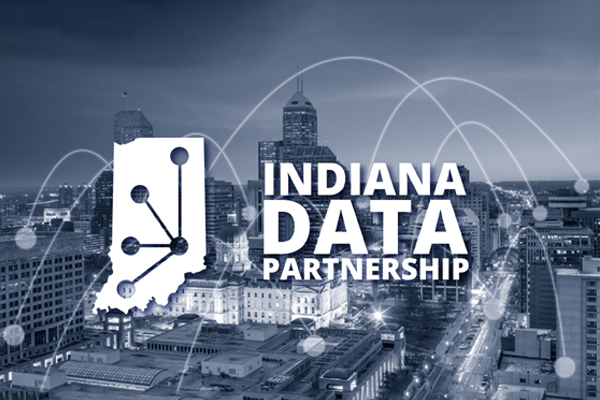To build an improved technological platform to support broader and more efficient data access, including a public-facing portal, MPH enlisted three of IU's nationally recognized centers for data-gathering and analysis—the IU Public Policy Institute, the IUPUI Polis Center and the Indiana Business Research Center. These units have also helped create a comprehensive "cluster network" of state and local organizations, including government agencies, universities, non-profits and private businesses, that are closely connected in efforts to address two significant challenges to communities across the state: educational and workforce development and substance abuse.
"The collaboration among these leading IU centers in direct partnership with our state is truly unprecedented," says David Gard, IU assistant vice president for university economic engagement. "The Indiana Data Partnership is harnessing the collective and complementary resources of these institutes, which represent three standout IU schools featuring unique talent and expertise, and deploying those resources in coordinated fashion to solve several of the major issues impacting our state. The partnership recognizes that cross-university collaboration is essential to addressing these complex challenges and helping Hoosiers improve their quality of life."
Addressing addiction, developing the Hoosier workforce
Addiction is one of the largest problems facing communities across Indiana, which saw the loss of 2,321 Hoosiers to drug overdoses in 2020, a 38 percent increase from the previous year. Over the last decade, Indiana has consistently ranked in the top half of U.S. states and territories for the highest drug overdose death rate, and it has consistently had a higher overdose death rate than the U.S. average. While both urban and rural Indiana counties have experienced high overdose death rates in recent years, rates among rural populations, who often have difficulty accessing treatment resources and social support services, continue to stand out.
As Indiana's opioid epidemic has increased, so too has the need for a clearer picture of the service provider landscape in counties across the state. To this end, the IDP is using social network analysis and cluster mapping to help the state better understand the full breadth of education, advocacy, prevention, treatment and recovery services needed to respond to the opioid crisis, and where critical service gaps exist. As part of this initiative, which is being led by the Polis Center, a unit within the School of Informatics and Computing at IUPUI, the partnership is identifying organizations currently engaged in substance abuse-related work, as well as entities that are not engaged but potentially could be based on the services they provide and their capacity. It is also supporting organizations in their use of data for strategic planning, grant writing, program creation, communication strategies and identification of resources to address the opioid crisis. A pilot program, which began in Marion County, the state's largest county (population over 977,000), has been expanded to include Howard, Allen, Cass, Fayette, St. Joseph, Marshall and Montgomery counties.
The IDP is also leveraging its networking and data analysis expertise to ensure Hoosiers have the talent and experience to meet the needs of Indiana's leading employers. As such, its efforts are helping to advance a key goal of the Governor's Workforce Cabinet, formed in 2018 to better align IU's education and workforce development programs. As part of this initiative, the Indiana Business Research Center, which is headquartered at IU's acclaimed Kelley School of Business, has tapped its reservoir of corporate relationships to identify and map public and private organizations across the state that are working to enhance local workforce ecosystems. Focusing on such organizations as EmployIndy, a workforce investment board in Marion County and one of 12 such boards throughout Indiana, the IBRC is helping the state identify a "supply chain" cluster for where Hoosiers can obtain education or workforce assistance, while also identifying potential new connections and partners that can expand the state's talent development system.

"What these and other projects have shown us is that—even though our decision-makers sometimes want to think there's a magic bullet to solve particular problems—in fact, there have to be multiple solutions," says David Bodenhamer, executive director emeritus of the Polis Center and professor emeritus of history and informatics at IUPUI. "Our state is much more diverse in the ways it organizes itself than we sometimes want to recognize. This has challenged us to envision new ways to identify all of the various organizations working to solve major challenges facing our communities, to connect them with one another and to tap as much of Indiana's intellectual capacity as we can to address these problems. That's the groundbreaking nature of this partnership."
Making big data accessible and actionable
As Indiana continues to add resources, support and information systems in pursuit of improved Hoosier health and increased economic mobility, it has inadvertently created a complex system that is not always efficient or easy to navigate. At its core, the Indiana Data Partnership is intended to make big problem-solving data easier to discover and analyze, and facilitate connections among organizations with complementary missions, assets and strengths.
"When talking about data and, specifically, big data, everyone is interested in finding and collecting it. But the bigger question is: 'To what end?,'" says Tom Guevara, director of the IU Public Policy Institute, which is housed in IU's top-rated Paul H. O'Neill School of Public and Environmental Affairs. "With the establishment of this partnership, we're taking this data and turning it into something more actionable. We're informing our leaders and helping them to make big public policy decisions. We're also putting together an infrastructure that enables us to add significant value to the good work that service-oriented organizations across our state are already doing."
Prior to joining the Public Policy Institute in 2017, Guevara spent six years as deputy assistant secretary at the U.S. Department of Commerce's Economic Development Administration. In that role, he led the federal economic development agenda, promoting innovation and competitiveness to help U.S. workers and businesses compete globally. He is enthusiastic about the partnership's early successes in highlighting how organizations can more effectively share and employ data analytics and build their collaborative networks to solve complex problems.
"Sometimes the methodology that states bring to problem-solving is a function of organizations working in silos and focusing only on their own missions," Guevara says. "What the IDP does is it allows Hoosier organizations to get out of this kind of restrictive environment and apply a much broader set of data-informed thinking to trying to solve the very difficult challenges facing our communities."
Carol Rogers, co-director and CIO of the Indiana Business Research Center, works extensively with economic developers, government officials and businesses throughout Indiana and the nation, providing them with economic and demographic information for and about Indiana and its localities. Under her direction, the center's award-winning interactive web service, STATS America, has become one of the most-used public data sites in the nation, along with its sister site, STATS Indiana.
Rogers envisions the IDP leading to even greater access to and sharing of information among Indiana's leading workforce and higher education agencies, while showcasing the value of IU's rich data centers. What's more, she hopes the partnership will inspire the types of flexible, solution-oriented data-sharing environments employed by today's most innovative and forward-thinking businesses and technology startups.
"Our dream is that, through the IDP, our state's organizations know more about what helpful and accurate data are available to them and start to use that data to determine what policies are working or not working," she says. "To us, these evidence-based data are a huge way for policymakers to really understand the long-term implications and consequences of their actions."
"It will be exciting to see how IU partners with organizations to use these tools in an impactful way moving forward," said Josh Martin, Indiana's chief data officer and executive director at MPH. "There is power in collaborative partnership and innovation. This will continue to grow as we add more partners, implement additional evaluation methods and identify new use cases that work within the established infrastructure."
Partnering for a true public good
The IDP was created prior to the COVID-19 pandemic, which has dramatically underscored the critical nature of effective data sharing and agency coordination toward ensuring the health and economic vitality of the state.
"With the COVID crisis, one issue our state and others faced right away is where are the data that will help us understand the implications of COVID," Bodenhamer says. "Part of this was knowing how many cases we had and how many tests we were conducting. But we also needed to develop a data hub that showed the geographic impacts of the pandemic and how it was affecting our different communities.
"Fact is, we have a state department of health and 92 county health departments. As such, there were gaps in the data, and the data themselves weren't always well described. Different counties had different data sets that needed to be reconciled, and data at the county and state level wasn't always archived very well or at all, depriving us of a longitudinal look at our health situation."
The IU members of the IDP hope the partnership will serve as a model for how organizations—including those with seemingly diverse missions and structures—can come together and leverage their strengths to solve big problems.

"In the past, we centers tended to be territorial," Bodenhamer says. "Even though we all worked with data, we had our own projects and worked with own specific audiences. But with this groundbreaking partnership, a supportive state government and community groups that continue to signal a need for better coordinated data—that's gone away, and our initiative has taken on added significance."
Rogers says that by breaking down information silos, which can afflict even the most well-intentioned service organizations, the IDP is revealing new networks of organizations that can bring multiple perspectives and ideas to big problems.
"State agencies don't always have the time or capacity to research problems themselves," she says. "They have to hire people to do research or can only do descriptive analysis. We have people at Indiana University who are trained scientists who are able understand and parse problems, pose hypotheses and test those to determine if there is a causal relationship. States often get a lot of turnstile data of the 'how many, how often,' variety, but to solve complex problems you need to have people who can understand that data more deeply and the best way to use it."
With several large projects well under way and a growing knowledge base, members of the IDP are hoping to enlist other collaborators, data sources and potential investors in the partnership. The University of Notre Dame, home to the Center for Social Science Research at the Lucy Family Institute for Data and Society, joined the partnership in 2020. IDP is also working to add Purdue University to the partnership team.
"Almost everything today is a complex problem," says Guevara. "And the only way we can create solutions or systems to address this complexity is to work with other organizations with complementary strengths.
"What we're really ultimately working for is a true public good. This is the reason for our existence. Our centers and this larger partnership were founded to get out there and do something good for our fellow Hoosiers and to help them improve their quality of life. It just so happens that we're doing this with data and policy analysis."



